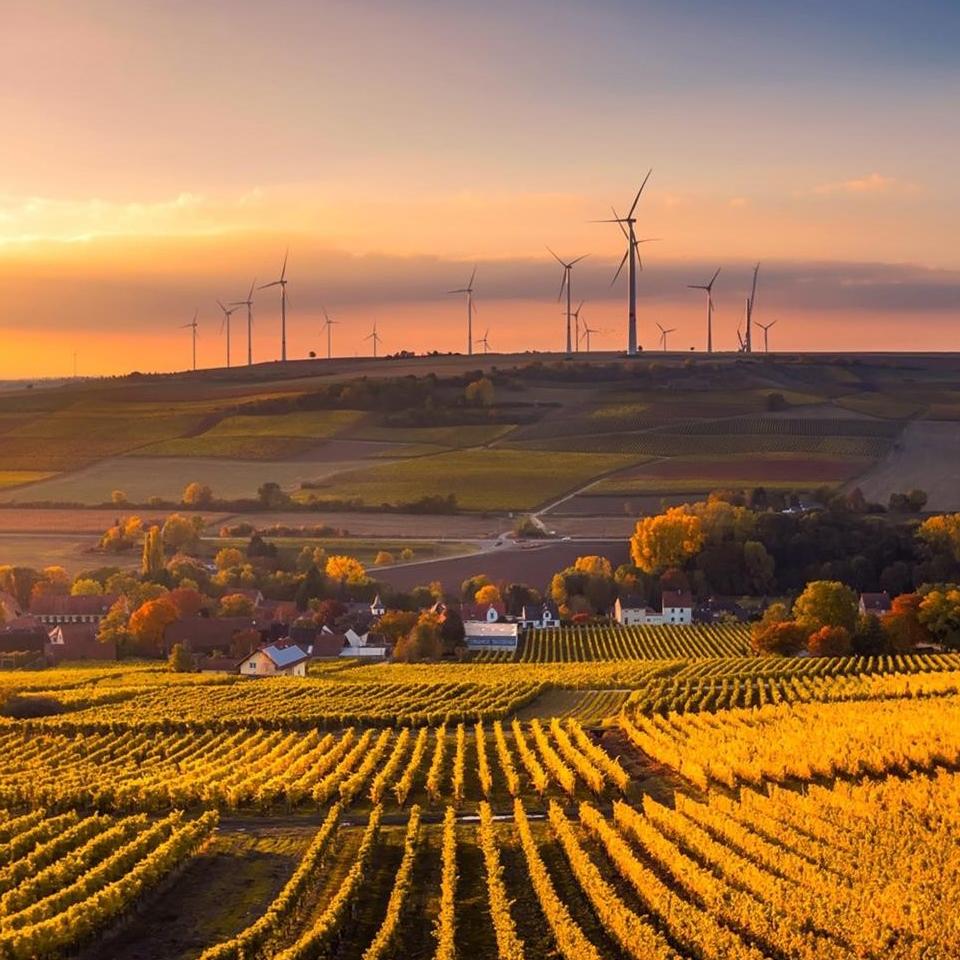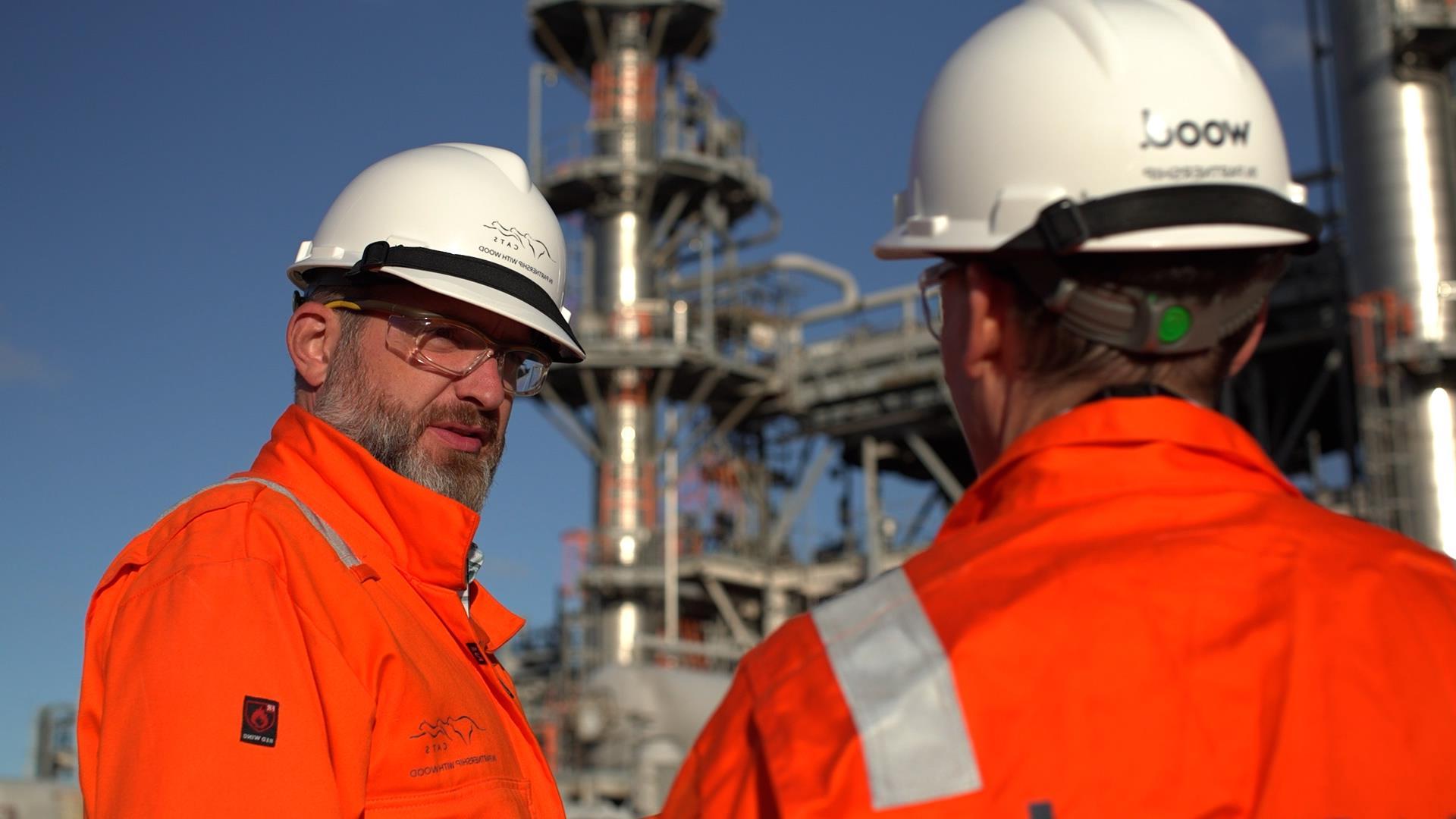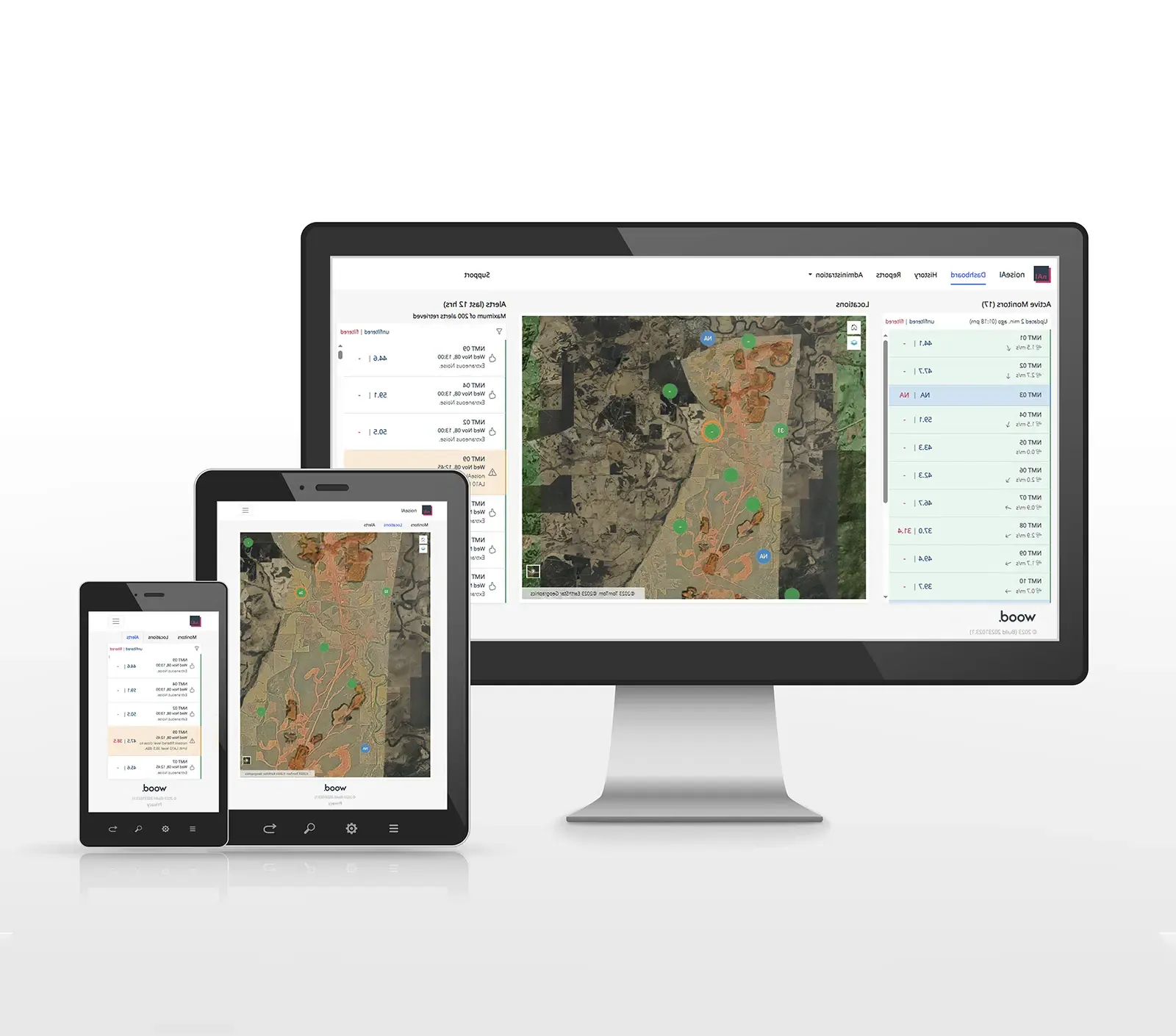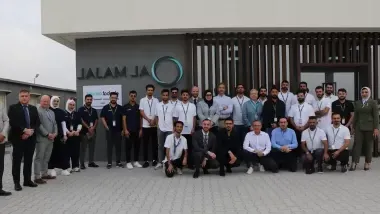Active listening – how AI can optimise performance at noise-constrained facilities
Improving noise management and optimising performance at noise-constrained facilities, worksites and for environmental monitoring
Increasing urbanisation and awareness of environmental health, worker safety and biodiversity is pushing companies to improve the management of noise emissions. Operators need accurate and timely data to manage health, safety and biodiversity issues proactively.
Being a responsible neighbour and maintaining positive relationships with community stakeholders is critical for safeguarding your operational license or planning expansions.
Wood noiseAI identifies and classifies sounds of interest such as industrial noise or animal calls, allowing users to meet regulations and improve productivity while protecting their social license to operate.
Powered by cutting-edge machine learning technology, noiseAI automates the otherwise time-consuming assessment of complex noise monitoring data instantly and as accurately as human experts.
Get instant and accurate insights
from acoustic data
Focus on operation-related issues
Increase productivity, safely

Where noiseAI can help
noiseAI has been successfully deployed for major industrial and environmental noise and sound monitoring projects, including wind energy, ports, construction, mining operations, smart cities and species monitoring
Environmental noise control
Transform environmental noise monitoring and assessments at industrial sites.
Traditional methods like environmental noise surveys and continuous noise monitoring supported by human experts have been the norm to ensure industrial noise, such as from production facilities, mines, ports, airports, wind turbines or construction sites stays within allowable limits.
However, measuring and analysing high-resolution data streams often involves a trade-off between speed and precision.
noiseAI for community can automatically detect emerging noise issues, saving vast amounts of manual work and enabling proactive action to prevent limit breaches and swift response to complaints.
The technology can reduce false alerts by 95%, improving operators’ ability to avoid or respond to actual noise exceedances while minimising the impact on communities, compliance and production.

Workplace noise monitoring
Identify and reduce occupational noise exposure at production facilities.
Workers across many industries are exposed to noise above occupational exposure limits (OEL), which can lead to noise-induced hearing loss if not addressed in time.
noiseAI for workplace can identify noise sources and their contribution to exposure with clear, actionable data. Integrated with wearable sensors, the system can automatically identify noise hazards and protect workers in real-time.
noiseAI can further measure and predict the effectiveness of noise control solutions on noise exposure.

Remote monitoring of endangered species
Monitor populations of at-risk species in remote habitats.
The impact of industrial operations on endangered wildlife is a pressing concern for operators, regulators and communities alike.
Traditional methods for collecting and monitoring animal sounds in remote locations can take up to four months to retrieve and interpret data.
noiseAI for species monitoring works remotely in any location and can produce highly accurate results within 24 hours, significantly reducing workload and providing timely insights to help protect endangered species and their habitats.

How it works
noiseAI converts high-resolution acoustic data into actionable insights.
The technology can be deployed in automated analytics applications in the cloud, on-premises or in hardware at the sensor (edge) when a high-bandwidth network is unavailable. Because noiseAI is sensor- and platform-agnostic, it can easily integrate with your existing measurement and control system.
You can implement noiseAI without risk and cost, including analysis of your site's historical noise levels and noise management actions.
Our team of specialist noise consultants is available to demonstrate the value of noiseAI in advance and assist you with implementing the optimal noise management solutions for your requirements.

How noiseAI can improve outcomes at your site
- Classifies sounds as they are sensed, providing deeper and more timely insight that enables bolder noise management action
- Unlocks missed production opportunities, avoiding restrictions by false alarms and overly conservative curtailment while maintaining compliance
- Relieves analysis burden and allows operators to focus on managing production-related noise levels by eliminating the ‘noise’ in the data
- Ensures consistency in noise evaluation, with 24/7 availability
- Supports accountability and transparency for reporting, auditing and quality control. AI performance can be supervised by subject matter experts through regular benchmarking.
- Integrates with existing systems; sensor agnostic and remote-deployable via cloud infrastructure
- Reduces noise management costs; available through a monthly subscription without setup fee
See if noiseAI works for you
You can improve outcomes at noise-constrained facilities and worksites. We use noiseAI to show you how.
As part of a free demo, we’ll show you how noiseAI can provide actionable and timely data for your facility, workplace or project, without increasing the risk of noise complaints or non-compliance.
Schedule a quick demo, send us your questions or request a quote today and one of our noise consultants will get back to you shortly.
noiseAI FAQs
General
What is noiseAI?
noiseAI is an artificial intelligence (AI) technology that automates the classification of large acoustic data sets with minimal effort and high accuracy. Applications of noiseAI include:
- Remove extraneous noise and quantify the level of industrial noise levels in environmental monitoring data
- Quantify the contribution of sources contributing to worker exposure in workplace noise dosimetry surveys
- Identify the presence of animal calls in passive acoustic monitoring data
How does noiseAI work?
noiseAI uses machine learning to classify acoustic data, including audio and noise level data.
noiseAI is trained by Wood’s subject matter experts, who have extensive experience in monitoring and quantifying environmental and occupational noise from industrial facilities and identifying animal calls in passive acoustic monitoring data.
How accurate is noiseAI?
noiseAI is trained with real-world data. Customised models are developed to optimise outcomes and achieve the highest possible accuracy. Combined with routine performance validation, noiseAI provides high accuracy and confidence in the outputs.
How do I know if noiseAI will work with my data and systems?
We are dedicated to understanding your situation and exploring how noiseAI can help you.
Our consultants can assess samples of your data and advise on the expected accuracy and suitability of noiseAI for your needs.
Contact us via the contact form above for further information.
noiseAI/community
How can noiseAI/community help manage environmental noise?
noiseAI/community accurately identifies noise emissions from industrial operations by filtering out irrelevant noises from monitoring data, such as wind, birds and traffic.
Results are displayed on a web application, providing a clear and concise assessment of environmental noise impacts on the community in real time.
This reduces time and effort spent addressing noise alerts from environmental noise monitors while avoiding unnecessary production loss, helping to maintain your social licence to operate within the community.
Will noiseAI/community help reduce the time spent managing noise alerts?
Industrial noise is typically managed according to noise regulations, with noise monitors triggering alerts when noise limits are exceeded.
However, a significant portion of these alerts are typically false due to factors such as wind, birds, or local traffic. Extraneous noise alerts can make up >95% of all alerts. Manual review of these alerts is both time-consuming and inconsistent due to personnel inexperience or bias.
noiseAI/community automatically filters out irrelevant sources and assesses industrial noise levels, significantly reducing false alerts requiring manual review.
For example, a mining operator utilising noise monitoring to regulate community noise levels has experienced a 95% decrease in alerts since implementing noiseAI/community. This translates to an estimated reduction of around 2,000 hours of operator time per year .
Is noiseAI compatible with my noise monitoring system?
Yes, noiseAI is system-agnostic and can be configured to operate on numerous types of existing monitoring systems, including Bruel and Kjaer, Svantek and Rion. Contact us to confirm if your existing noise monitor is compatible.
Can I use noiseAI/community to demonstrate compliance with regulatory noise limits?
Yes, noiseAI/community can be used to demonstrate compliance against regulatory limits. It can process large monitoring data sets and zoom in on periods where industrial noise is dominant to prove noise regulation compliance.
noiseAI/fauna
How does noiseAI/fauna detect animals?
noiseAI can detect fauna vocalisations and automatically classify animal calls in passive acoustic monitoring data. Machine learning models are trained by Wood’s specialists, using real-world data, and are customised and optimised to achieve the highest possible accuracy.
noiseAI/fauna can be deployed as an automated device-to-cloud technology stack for online monitoring or post-processing of large acoustic data sets.
How does noiseAI/fauna automate acoustic monitoring?
noiseAI/fauna can be deployed as an automated device-to-cloud technology stack for online monitoring. The technology relies on the use of a noiseAI model, which is deployed on a computing unit that is co-located with an acoustic monitor. Acoustic data captured at the monitor is automatically processed using the noiseAI model. Classified vocalisations of interest are timestamped and transmitted to a cloud-based server. Results are then presented to the user on an interactive dashboard.
Can noiseAI/fauna be used in remote environments?
The noiseAI technology stack works with low bandwidth network connections, such as satellite or IoT networks. This allows online monitoring of fauna at locations well beyond the reach of cellular networks.
Furthermore, the devices are designed for low-power use and can operate on small solar or battery-powered systems.
What are the benefits and advantages of automated monitoring using noiseAI/fauna vs traditional passive acoustic monitoring programs?
Automated noise monitoring with noiseAI/fauna has several advantages compared to traditional passive acoustic monitoring programs:
- Get immediate results enabling management action in response to changes in fauna activity levels
- Identify and troubleshoot issues remotely, avoiding large gaps in data
- Significantly reduce costly and hazardous field work required to retrieve data via SD card changes
- Eliminate the time and effort required for manual processing of acoustic data for species identification
What species can noiseAI/fauna detect?
noiseAI models can be trained to detect vocalisations from any species. It can be used wherever passive acoustic monitoring is used for species detection. Models are tailored to achieve the highest performance possible for the species of interest. Some examples of species where noiseAI has been used with high accuracy include:
- Canadian bat species (including Little Brown Bat, Tricoloured Bat and Northern Long-Eared Myotis)
- Australian bat species (including Pilbara Ghost bats, Pilbara Leaf Nosed bats)
- Australian cockatoos (Carnaby’s, Baudin’s and Red-tail black cockatoos)
noiseAI/Fauna has also been used to detect pest species, such as the Cane Toad.
noiseAI/workplace
How does noiseAI/workplace detect noise sources?
noiseAI/workplace can detect and classify significant noise sources to protect operator health and safety. Continuous audio recordings from compatible dosimeters are analysed using noiseAI/workplace to identify significant noise sources, including intermittent and impulse sources such as hammers and rattle guns.
How can noiseAI/workplace help protect workers from high noise exposure?
noiseAI/workplace can identify and quantify exposure from individual noise sources, allowing for a recommendation of targeted and data-driven noise controls to reduce operator noise exposure.
noiseAI/workplace outputs are displayed via an interactive and customisable dashboard. The results can be assessed against worldwide noise limits, guidelines or regulations, including:
- USA OSHA regulations
- Canadian Occupational Health and Safety Regulations (SOR/86-304)
- Australian Safework WHS Regulations
- European EU Directive 2003/10/EC
- UK HSE Control of Noise at Work Regulations
noiseAI/workplace can also verify the effectiveness of noise controls.
Can noiseAI/workplace be used to assess worker noise levels against Occupational Safety and Health Administration (OSHA) permissive exposure limits (PELs)?
Yes, noiseAI/workplace will be configured to assess against your company, state or federal noise limits, guidelines or regulations – including OSHA’s PEL.
Results are presented on an interactive dashboard, which allows for a direct assessment against OSHA’s PEL. Results can be exported into Excel and other formats, allowing for upload with OHS databases such as Cority.
How does noiseAI/workplace differ from a noise survey and traditional dosimetry campaigns?
Standard noise surveys use interviews with site personnel to help determine average exposure times to significant noise sources. Alternatively, traditional noise dosimetry campaigns generate statistical data based on sampled overall noise levels.
noiseAI/workplace determines exposure times to significant noise sources based on measured data, providing unparalleled insight into worker noise exposure not available through traditional noise surveys or dosimetry campaigns.
noiseAI/workplace provides granular insights into noise dosimetry data, allowing for a reduction in operator noise exposure through targeted, data-driven noise control measures.
Other applications
Can noiseAI be used to detect faults and anomalies in machinery?
noiseAI can be used to detect faults and anomalies in equipment. However, traditional methods of fault detection, such as condition monitoring using vibration, may be more effective. Contact our condition monitoring specialists to determine the most suitable method for your use case.













